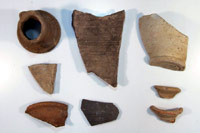
Classics scholars will be interested in our small collection of artefacts from the ancient world, which includes items from two sites in Roman Britain, each of which is believed (by some) to be the fabled mythical location of King Arthur’s Camelot.
The artefacts, along with a collection of books, were donated to the University in January 2003 by the Reverend Wardlow Little and his wife. The Reverend Little is a retired teacher of Classics who taught Greek and Latin at a number of Sydney schools in the 1950s – 60s.
This “Little” Collection consists of around 120 objects, most of which represent the fruits of a 6-week archaeological dig conducted in 1960 at Viroconium (the ancient name of Wroxeter in Shropshire) and a nearby Iron Age hill-fort. Other sites in Roman Britain represented by artefacts include Caerleon (“City of the Legion”) near Newport in Southern Wales and Mawgan Porth in Cornwall. Viroconium was the fourth largest city in Roman Britain and was first settled by the Romans in AD48. Both Viroconium and Caerleon have their supporters as possible sites of King Arthur’s legendary capital, Camelot.
Iron Nail artefacts
Besides artefacts from Roman Britain, the collection also includes items from the Greek islands of Aegina and Sphacteria and the ancient city of Gournia, known as the “Pompeii of Minoan Crete”. Sphacteria was the site of a major battle of the Peloponnesian War recorded by Thucydides, where the Athenian general Demosthenes captured the Spartan forces.
 |
 |
Professor Harold Tarrant, Head of the School of Liberal Arts at the University, said that while the collection was small it was not insignificant and would be a significant teaching tool for the University’s scholars and students of Roman Britain, as well as a wonderful addition to the University’s special research collections. “We’re very interested in creating and expanding the University’s collection of such artefacts, I would encourage more donors to come forward and consider depositing their collections with the University of Newcastle, our staff and students would greatly appreciate such a gift” he said.
 Professor Harold Tarrant, Head of the School of Liberal Arts with Dr Edward Bridle, Archivist and Anglo-Saxon Scholar |
Various Metal Artefacts from Viroconium
The artefacts represent the University’s oldest examples of ancient European culture and are available for viewing in the Archives Rare Books & Special Collections Reading Room in the Auchmuty Library. All Welcome.
24th January 2003












I have stumbled here from tagsurfer at wordpress on Roman Britain, an interest of mine. Whilst I am delighted that these artefacts are preserved and safe, how on earth did they go from Wroxeter in 1960 to you in 2003? Long-term loan or “borrowed”?
Hi, See our story on the Collection and how it reached us here:
https://uoncc.wordpress.com/2010/04/13/viroconium/
See this video story:
I live thirty miles from Wroxeter and am currently working to collate Roman and other finds in a parish on the eastern edge of Shropshire. The displacement of these ‘Little’ finds is shocking but is happening all the time. One of the benefits of the internet is that they can be linked virtually if not actually with their home.